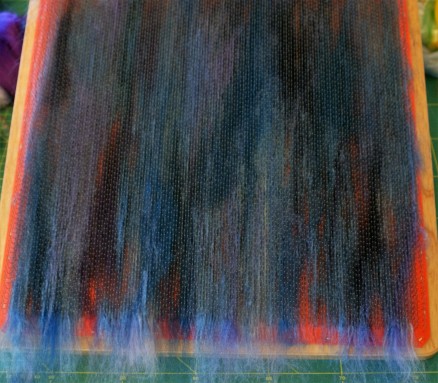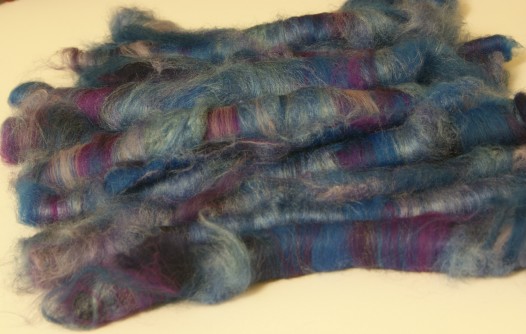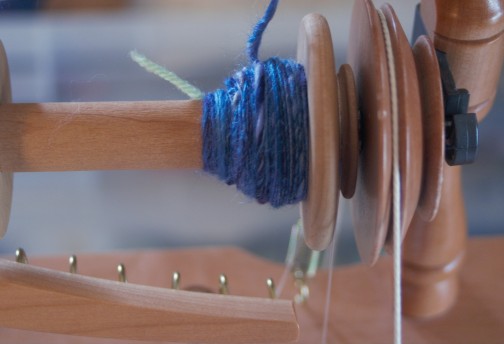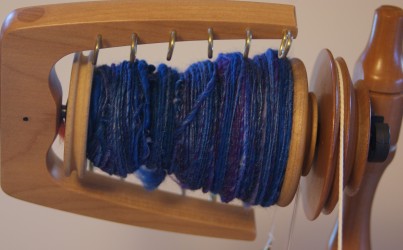It’s Spinzilla week! For those of you who aren’t familiar with Spinzilla, it’s a week for burnt thumbs, sore shoulders and empty-looking stashes as you spin as much fibre as you can in a week.
While spinners across the globe eagerly awaited the clock to strike midnight for spinning time to commence, with their piles of combed top and carded batts prepped for the wheel, I was struggling to sleep with what was going to turn out to be a really miserable cold. My fibre stash also better resembled an aimless fluff pile than anything with a plan in mind.

That’s why Day 1 of spinning time turned into Day 1 of fibre prep time…
Despite having a fairly sizeable stash, and plenty of projects ready to be spun, I ended up deciding I wanted to do something entirely different…. Then realised I didn’t have quite enough fibre to make an amount I’d consider worth knitting… So off to the blending board it was.

The mulberry silk is handpainted with acid dyes and I’ve blended it 50/50 with some various dyed merino. This is actually one of the first pieces of silk I ever dyed and I’ve been trying to think of a way to use it for something special. I really like pure silk yarns, but even spun super fine, 50 g doesn’t go that far in terms of thinking of an actual end use for the yarn.

Much as I whinge about merino’s proclivity to hairiness, it really is the best fibre for always being there in the exact colour you need. Until I one day go on a mad dyeing spree and have a stash of Shetland in every shade that is. I tried to pick a range of colours that matched some of the shades in the silk to keep the subtle feel of the blues and purples.

Although I find it’s easier to get more ‘heathered’ colours on hand carders, I find it’s easier and far less time consuming to make more consistent rolags on the blending board. If you’re having trouble getting the rolag started, which is easily the hardest point, flick up the fibre with your fingers from the first few rows of teeth so you have a decent amount to roll onto the sticks.
Another advantage of blending board rolags is they always seem to be a lot less delicate than those off hand carders! There’s also something slightly comical about rolling the entire board into a mega size rolag too.

It’s amazing how well silk stands out, even if it is only included as a very small percentage in a blend. I was a little concerned about how well the original colour of the silk would keep in the blend but it looks just fine, particularly where I’ve laid thicker areas on the board. I like how the darker colours in the merino stop the silk looking a little washed out and pale too.
Spinning blends of fibres that draft quite differently comes with its challenges. Silk tends to be a bit more ‘slippery’ than wools, so can be pulled in more quickly if they aren’t blended thoroughly. Some people find spinning from the fold helps with this but with merino and silk I don’t find it necessary if the fibres are predrafted how I want.

I was hoping to make a 2-ply fingering weight yarn, which came as a bit of a shock to the fingers after mostly spinning as fine as I can. I’ve also been spinning mostly silk, so merino almost feels like a drag to spin and draft but after a bit of warming up, I was making decent progress. The most important lesson I have ever learnt, when you’re having any woes with spinning, is to predraft. Spinning too thin? Predraft. Too thick? Predraft. Uneven? Predraft. I’m not sure if you can solve all of life’s problems with predrafting but it might be worth a go.

Day 2 and I had 1.5 full bobbins and 2 rolags to go! Looking forward to plying this one!
This is lovely – really looking forward to seeing your completed yarn! And I like your advice on Predrafting too – yes, perhaps it does apply to more than spinning 🙂
LikeLiked by 1 person
Thanks! Just finished yarn number 1 which isn’t quite the thickness it’s supposed to be but I love the colours. Next one is going to be some idiotically fine singles… Wish I could predraft colds away too!
LikeLike